Location De Voiture Pas Cher Leclerc
12 Top-Rated Tourist Attractions in Nord-Pas-de-Calais
We may earn a commission from affiliate links ()
On a map of France, the Nord-Pas-de-Calais region forms the northernmost tip of the country'southward Hexagon. At the border of Belgium and facing the English Channel, Nord-Pas-de-Calais boasts cute sandy beaches, besides as serene expanses of marshland, rolling hills, and pristine forests. The region corresponds with the historic provinces of Artois and French Flanders and overlaps with parts of Picardy.
Despite being one of French republic's almost important industrial areas, in that location are yet pastoral farms, celebrated towns, and quaint villages untouched by modernity. A charming ambience and tiptop-notch cultural attractions are also constitute in several cities such as Lille, Arras, and Boulogne-sur-Mer.
Plan a fabulous travel itinerary and discover the best places to visit with our list of the pinnacle attractions in Nord-Pas-de-Calais.
See also: Where to Stay in Nord-Pas-de-Calais
1. Lille
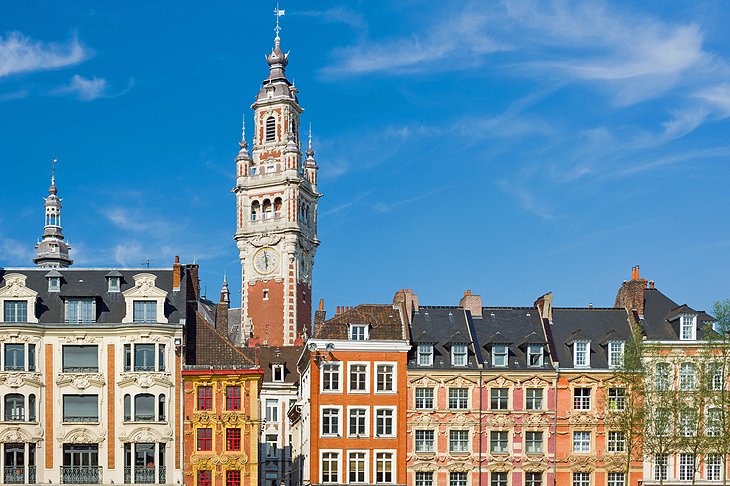
Lille is the largest city of French Flanders and has a distinctive Flemish character, seen in its lovely architecture and hearty cuisine. The local cooking includes typical Belgian dishes similar moules-frites (mussels and French fries) and gaufres (Belgian-manner waffles).
At the heart of Lille, the Place du Général de Gaulle, is lined with elegant Flemish Baroque monuments such as the Vieille Bourse (Old Stock Exchange). The nearby Rang du Beauregard buildings exemplify an ornate Lilloise Neoclassical style.
Fine art museums are among the top attractions in Lille and in nearby towns. Not to exist missed are the Palais des Beaux-Arts (Museum of Fine Arts); the Musée du Louvre-Lens, which shares its drove with the Louvre Museum in Paris; the LaM museum of mod and contemporary art in Villeneuve d'Ascq; and the drove of fine arts and decorative arts in the town of Roubaix.
The first weekend of September, the Braderie de Lille (Flea Market) brings together hundreds of stalls selling vintage items and antiques. Bargain hunting at the Lille Flea Market is one of the most pop things to do in the city.
2. Arras
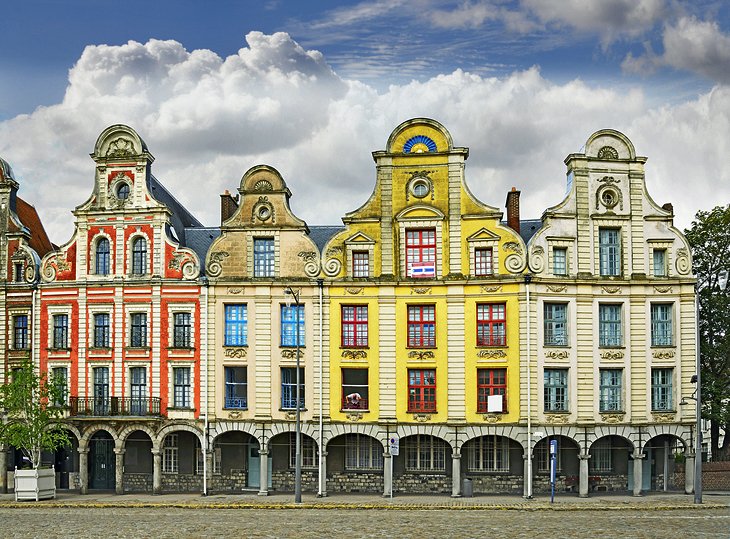
The historic capital of the Artois province, Arras has the architectural heritage to testify it. Arcaded squares, high-gabled burghers' houses, and exquisite old churches reveal the authentic grapheme of this Flemish town.
The Cathédrale d'Arras, originally the abbey church of Saint-Vaast, was rebuilt in the 18th century in awe-inspiring Neoclassical style.
Another edifice of the erstwhile Benedictive monastery of Saint-Vaast is now dwelling to the Musée des Beaux-Arts. This museum has a diverse art collection, from medieval sculptures to Dutch and French paintings. Highlights are the masterpieces past Jean-Baptiste-Camille, Corot, Charles Le Brun, Delacroix, and Rubens.
During World War One, the expanse around Arras was the scene of heavy fighting, which is at present commemorated by several military cemeteries and memorials. On the site where the pivotal Battle of Vimy Ridge took identify (12 kilometers northward of Arras) in Apr of 1917, the Vimy Memorial pays homage to Canadian soldiers who fought and died in France during the First World War.
3. Calais
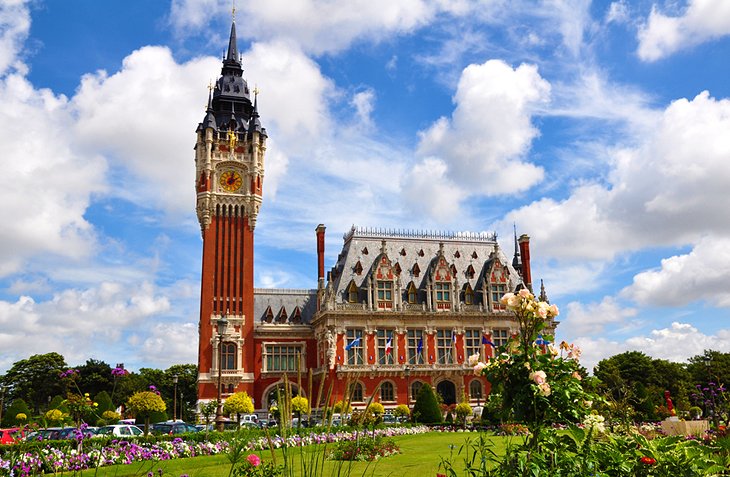
Calais provides a gateway to England as a port on the English Channel and the starting betoken for train or ferry rides to England. The high-speed Eurostar railroad train crosses the English language Channel's Strait of Dover in a 50-kilometer undersea tunnel, and takes under one hour to arrive in London. The English Channel crossing by ferry takes one hour and 30 minutes from Calais to Dover, England.
In this spectacular seaside location along the Côte d'Opale (Opal Coast), the area around Calais features expansive sandy beaches, which are pop for surfing and sailing, every bit well as other outdoor activities like hiking and cycling.
For those spending time in Calais (rather than simply traveling through), must-encounter attractions are the UNESCO-listed Flemish Renaissance-way Hôtel de Ville (Boondocks Hall) and the nearby grouping of Auguste Rodin'due south sculptures, Les Conservative de Calais , which commemorate the siege of Calais in 1347 by the English, and occupation until 1558.
Adjacent to the leafy Parc Richelieu, the Musée des Beaux Arts displays paintings and sculptures from the 16th century to the 21st century. Among the masterpieces are works by Auguste Rodin, Théodore Géricault and William Turner.
The Cité de la Dentelle et de la Mode (on the Quai du Commerce) has a superb collection of antique lace, too every bit an assortment of vintage fashion pieces that feature lace adornments. The collections focus on the history of handmade lace from the Renaissance era to the 19th century. All the same, there is besides an exhibit of modern lace and gimmicky fashion.
4. Boulogne-sur-Mer
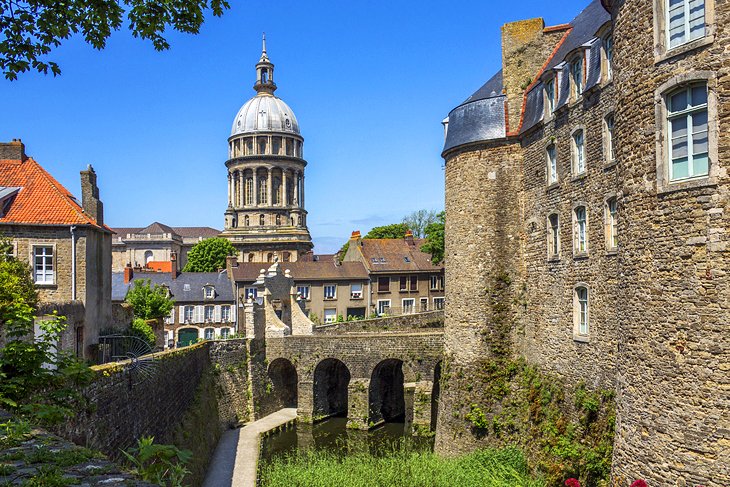
As France's largest fishing port, it's plumbing fixtures that Boulogne-sur-Mer has a superb aquarium and sea museum. The Nausicaá aquarium is the largest in Europe, abode to 58,000 sea creatures, including 1,600 different species. Nausicaá especially appeals to families with kids, who are sure to enjoy the touch pool and entertaining body of water lion performances.
Near the Nausicaá aquarium is access to a sandy beach along the Boulevard Sainte-Beuve. The beach has a yacht club and a promenade, which is ideal for taking a seaside stroll. During summertime, embankment tents, lounge chairs, and parasols are available for rent; in July and Baronial, lifeguards are on duty.
In keeping with its maritime heritage, the town hosts the Fête de la Mer (Festival of the Sea) every twelvemonth in July. The festival includes nautical parades, sailing excursions, maritime music concerts, performances of traditional seafaring songs, and visits to the fish auction and fishermen's quays. Gourmands enjoy the seafood cooking workshops taught by local chefs, and samplings of specialties prepared from fresh catches.
Tourists should likewise take some time to explore the Sometime Boondocks of Boulogne-sur-Mer, a walled medieval city known as the Haute Ville because it's perched on a hilltop. This charming historic area is full of atmospheric cobblestone streets and picturesque squares.
Highlights of the Haute Ville include the UNESCO-listed belfry, dating to the twelfth century; the Notre-Dame Basilica, which incorporates a Romanesque crypt; and the 13th-century fortifications (Les Remparts), which feature 4 gated entrances to the Haute Ville.
The ramparts that surround the Haute Ville of Boulogne-sur-Mer are the all-time preserved medieval fortifications in northern France. It's an invigorating experience to walk along the Promenade des Remparts, a path through landscaped gardens at the foot of the ramparts. This path likewise offers a chance to admire panoramas of the metropolis.
Some other interesting spot to explore is the Rue de Lille, a pedestrian street lined with restaurants, antique shops, and small boutiques.
five. Gerberoy
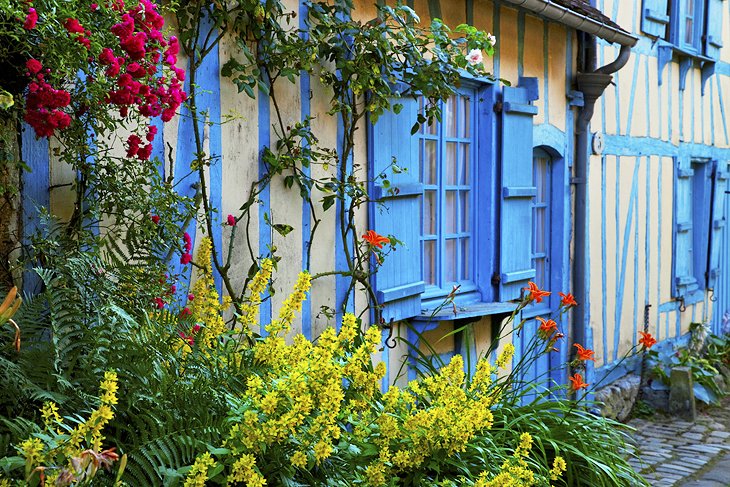
With its tranquil bucolic setting, cobblestone pedestrian alleyways, and quaint one-half-timbered houses, this medieval village is a delightful place to explore. Thank you to its dazzler and amuse, Gerberoy is listed as one of the Plus Beaux Villages de French republic (Most Beautiful Villages of France). The Touring Club of France titled Gerberoy as "le plus dally" ("the virtually alluring") village.
Many buildings throughout the town are adorned with rose vines. Gerberoy is also famous for its Fête des Roses (Festival of Roses), which has been held in the village every twelvemonth since 1928.
In keeping with the village'south love of flowers, the post-Impressionist painter Henri Le Sidaner (who settled in Gerberoy) created magnificent Italian terraced gardens that he used every bit an outdoor fine art studio. Classified as a Jardin Remarquable (Remarkable Garden), the Jardins Le Sidaner are open every day from May 1st through September 30th.
Near the garden is some other must-see landmark, the Collégiale Saint-Pierre, which is adorned with 17th-century Aubusson tapestries. The church dates to the 11th-century but was renovated in after centuries.
6. Bergues
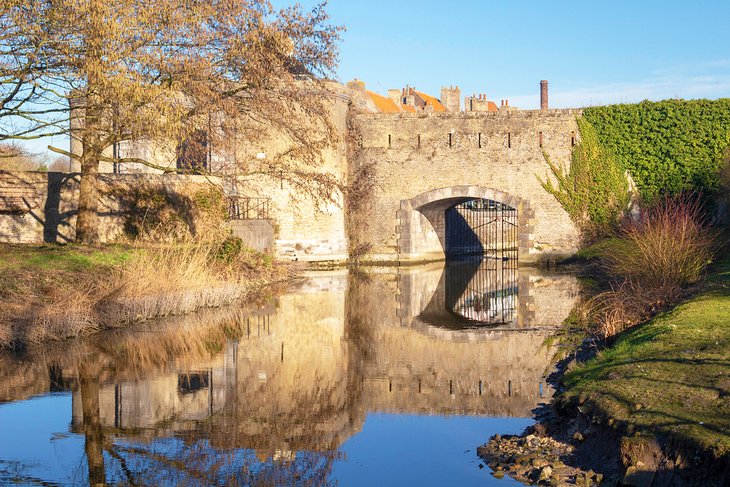
Surrounded past remnants of medieval walls, the picturesque town of Bergues is traversed by winding canals, which lend a typical Flemish ambience.
Bergues is well-nigh famous for its belfry, considered one of the finest in France. The UNESCO-listed Beffroi de Bergues features an unusual open blueprint, with 50 bells that chime to marking the hours. As the town's elevation tourist allure, the Beffroi de Bergues besides has an exhibition space and music room.
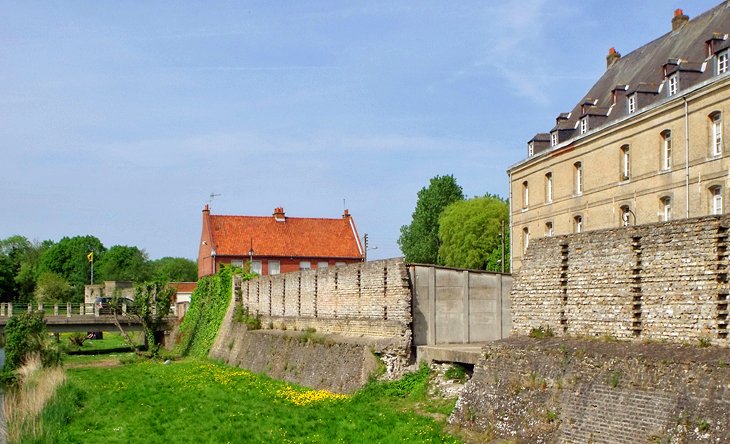
An exceptional fine arts museum, the Musée du Mont de Piété occupies the 17th-century Mont-de-Piété (municipal pawnshop), which is a gem of Flemish Baroque architecture. The museum displays paintings and drawings by Flemish and French masters, including George de la Tour, Charles Le Brun, Nicolas Poussin, Anthony van Dyck, and Maerten van Heemskerck.
seven. Musée Louvre-Lens
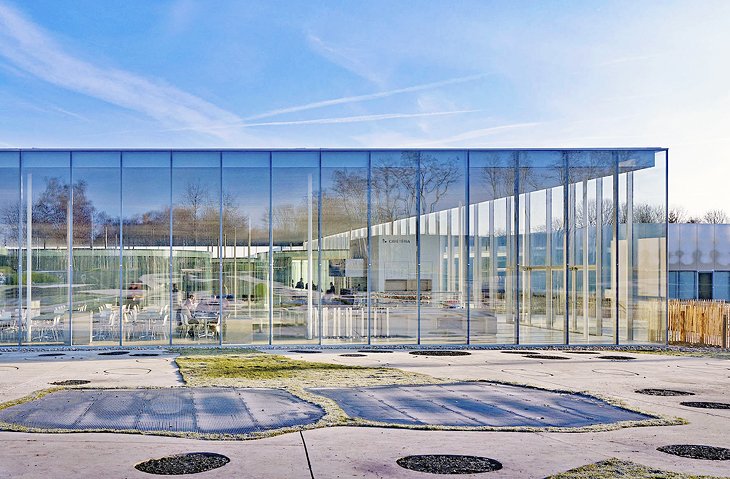
The Musée Louvre-Lens is an ultramodern museum space in a tranquil park. The Musée Louvre-Lens does non have its own collections, instead the museum presents rotating exhibits of artworks loaned from the Louvre Museum in Paris.
The museum's 3,000-foursquare-meter Galerie du Temps (gallery infinite) features natural lighting and an innovative presentation. On brandish are over 200 masterpieces from the Louvre. Many exhibits focus on specific themes of artworks compiled from various fourth dimension periods or representing dissimilar artistic styles.
It's easy to get to the museum from Lille (a xxx-minute drive) or Paris (90 minutes by train). The train station in Lens offers costless shuttle bus rides to the museum.
Address: 99 Rue Paul Bert, 62300 Lens
Official site: http://www.louvrelens.fr/en/home
eight. Cambrai
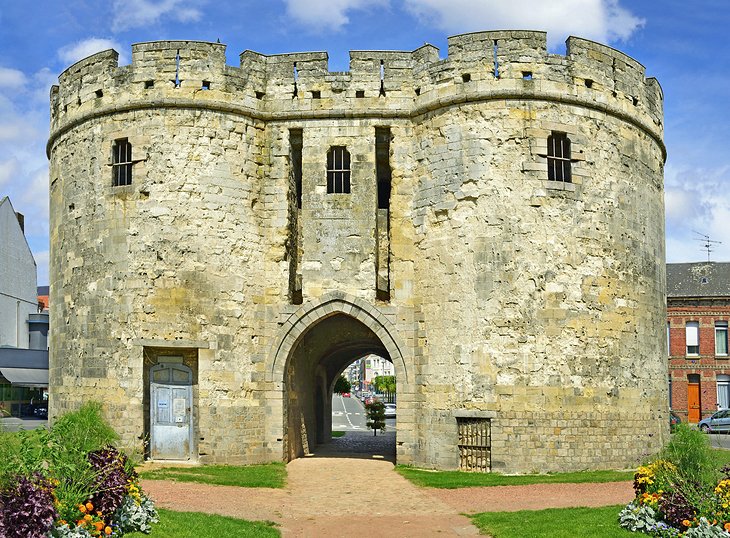
Cambrai is a quiet historic town with remnants of medieval fortifications and an impressive cultural heritage. A relic of the old ramparts, the 14th-century Porte de Paris one time provided an entrance into the previously walled town.
The Eglise Saint-Géry is noteworthy for its blend of French classical and Dutch Baroque architectural styles, as well as the famous Entombment painting by Rubens.
Nonhoped-for-missed are Chapelle du K Séminaire, renowned for its Bizarre facade, and the Cathédrale Notre-Dame, which contains exceptional works of art, including trompe-l'oeil paintings by Martin Gheeraerts and marvelous stained-glass windows.
Fine art lovers will appreciate the Musée des Beaux-Arts, which has an excellent array of 16th- to 19th-century Dutch and French paintings. The museum's archæology and contemporary art collections are likewise interesting.
Many cultural attractions are found just outside of Cambrai, including the Musée des Dentelles et Broderies de Caudry (Museum of Lace and Embroidery), housed in a 19th-century lace factory in Caudry (xv kilometers from Cambrai). This museum presents the local history of lace fabrication and embroidery arts along with craft demonstrations and fashion exhibits.
The Musée Matisse in Le Cateau-Cambrésis (25 kilometers from Cambrai) is a must-see allure for those who admire the works of Matisse. The museum was created past Henri Matisse, who hailed from this region, and is considered one of the most important collections of Matisse paintings in the world. On displays are 82 paintings that Matisse himself donated to the museum.
nine. Saint-Omer and the Marais Audomarois
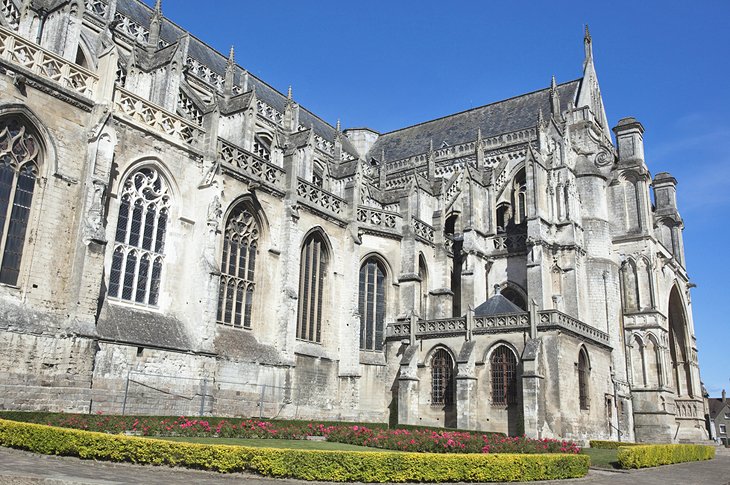
Cobblestone streets and stately former townhouses reveal the traditional character of this historic market town. One of Saint-Omer's almost elegant 18th-century townhouses, the Hôtel Sandelin, is at present a museum with an excellent drove of European paintings, too as decorative arts.
Other must-see landmarks are the 13th-century Eglise Saint-Denis, which has a majestic Gothic tower, and the Cathédrale Notre Dame, a excellent Gothic monument congenital between the 13th and 16th centuries.
In the surround, the Marais Audomarois (marshland) is among the best places to visit in northern France for fishing (allowed with a local fishing clan card) in the gentle rivers.
Taking a boat ride through the marshland'southward waterways is another fashion to discover the wetland scenery, with its lush constitute life and market place gardens. At that place are several options for tourists: traditional artisan-crafted wooden boats led by a local boatman, row boats and canoes for hire, and guided boat tours.
For those who'd similar to explore the terra firma aspects of the area, the Audomarois Forest has breathtaking trails for hiking and cycling.
10. Dunkerque
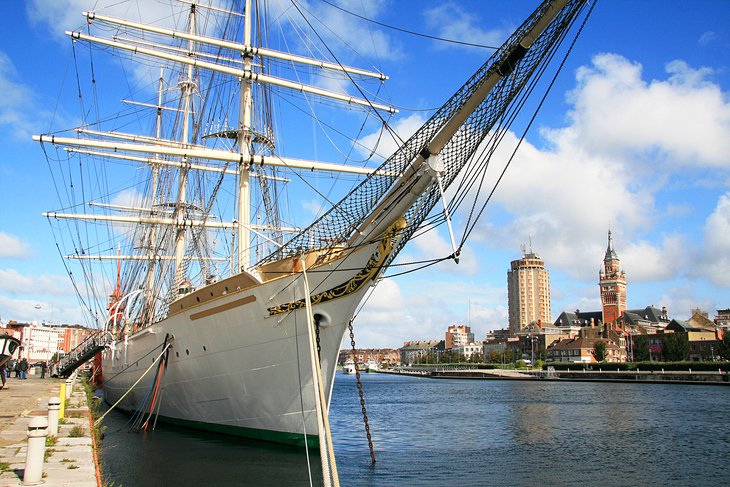
Just 14 kilometers from the Belgian border, Dunkerque (Dunkirk) is France'southward northernmost town, on the North Bounding main near the Strait of Dover. Dunkerque has an important commercial port, also as ferry boat access to Dover, England.
During the 2nd Earth War, Dunkerque was the scene of a dramatic military rescue as boats of Allied troops were brought to safety.
Every year before Ash Wed, the Dunkirk Carnival transforms the town into a wild and crazy scene of unbridled celebration. Thousands of revelers show their festive spirit, wearing colorful costumes; some carry whimsical umbrellas on long handles. The 3-day carnival includes gregarious processions, musical entertainment, and joyful balls.
11. Douai
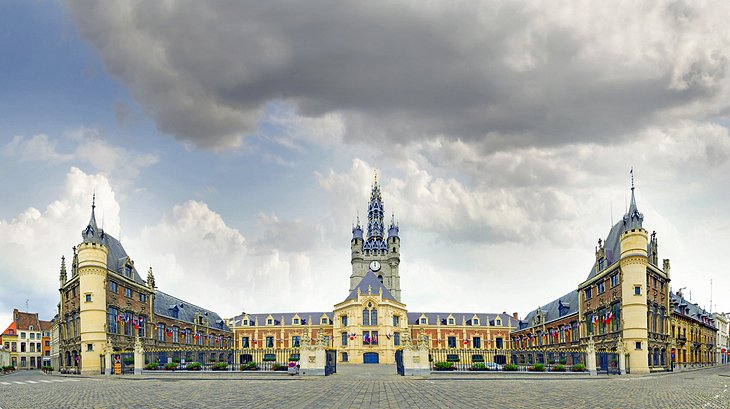
Douai is an old university town, originally founded by the Spaniards. The central features of the town are the UNESCO-listed Belfry, a masterpiece of Gothic architecture that dates to the 14th and 15th centuries, and the Place d'Armes, besides chosen the Grand Place.
The Musée de la Chartreuse, housed in a 17th-century convent, contains a renowned fine-arts collection including masterpieces of Flemish, Dutch, Italian, and French painting. Highlights are the works by Véronèse, Rubens, Courbet, Renoir, Sisley, Corot, and Pisarro, as well every bit the precious Polyptyque d'Anchin by Jean Bellegambe (created between 1509 and 1513).
12. Abbaye de Vaucelles
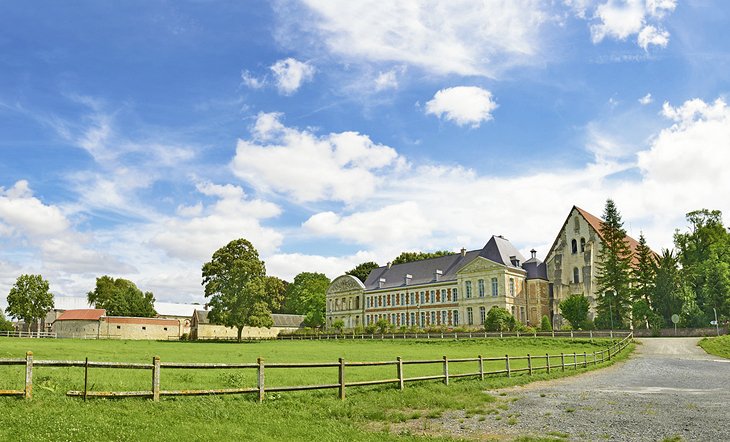
The Abbaye de Vaucelles is a remarkable 12th-century abbey founded past Saint Bernard, which was one of the largest Cistercian monasteries in the globe. The abbey is classified equally a Historical Monument and is considered one of the well-nigh important historic buildings in northern France.
Visitors can see the quondam Monks' Quarters, including a affiliate house, scriptorium, sacred passage, oratory, and chapel, and explore the luxuriant seven-hectare grounds, which feature diverse sections, including an orchard and a rose garden.
The Abbaye de Vaucelles is open to the public for visits (for an admission fee) every day except Mondays from March through October. Fine art expositions and cultural events are held here throughout the year.
The abbey is located 12 kilometers from Cambrai.
Where to Stay in Nord-Pas-de-Calais for Sightseeing
Nosotros recommend these delightful Nord-Pas-de-Calais hotels in Lille, Arras, and Calais:
- Clarance Hotel : luxury Lille boutique hotel, 18th-century townhouse, bright rooms, Michelin-starred eating place, vegetable garden.
- Hotel L'Arbre Voyageur, BW Premier Collection : mid-range Lille hotel, about the old town, contemporary building, serene rooms.
- Holiday Inn - Calais : 3-star Calais hotel, harbor views, five-minute stroll to beaches, secure motorcar park.
- ibis Arras Centre Les Places : budget-friendly Arras hotel, central location, friendly staff, sleek decor.
Nearby Attractions in the Picardy Region
Amiens
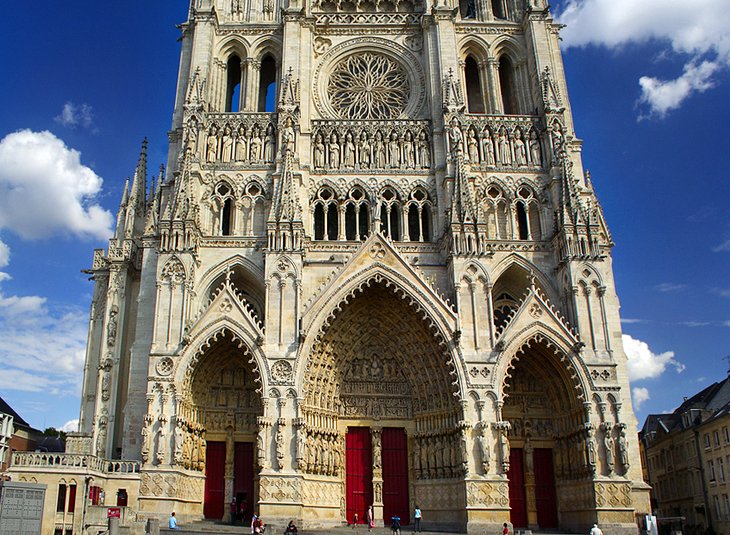
Amiens is the historic uppercase of Picardy and was long famous every bit a center of linen, wool, and cotton industries. The 2d Globe State of war took its price on the urban center. Fortunately, the magnificent Cathédrale Notre Dame d'Amiens was spared whatsoever damage.
The about impressive of Amiens' tourist attractions, this 13th-century cathedral is designated as a UNESCO Earth Heritage Site and is one of the largest Gothic cathedrals in the world. This superb example of classic French Gothic architecture is distinguished by its harmony and overall stylistic coherence. Visitors marvel at the intricacy of the facade with its exquisite details.
Beauvais
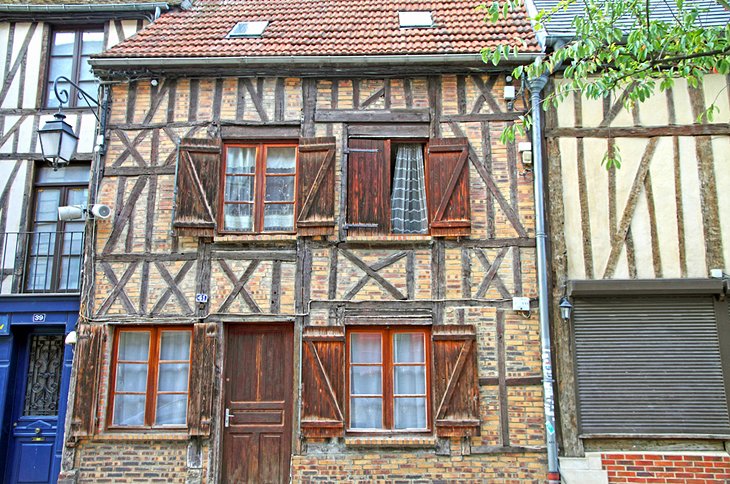
Beauvais has a distinctive sometime-world graphic symbol and noteworthy historic churches. Soaring towards the heavens, the Flamboyant Gothic Cathédrale Saint-Pierre boasts the highest roof vaulting in the world. Amidst the oldest churches in Beauvais is the Eglise Saint-Etienne, built in the 12th century with some later additions.
It's worth taking fourth dimension to admire the church's stained-drinking glass windows, especially the 13th-century Arbre de Jessé (The Tree of Jesse). Behind the cathedral is the Galerie Nationale de la Tapisserie, a middle of tapestry, which displays exceptional pieces dating from the 16th century and presents workshops on tapestry weaving.
About a 30-minute drive n in the village of Folleville is the UNESCO-listed Eglise Paroissiale Saint-Jean-Baptiste. This historic church was on the medieval "Way of Saint James" pilgrimage route to Santiago de Compostela, Spain.
Château de Chantilly

In the pocket-sized hamlet of Chantilly, the Château de Chantilly is one of the few castles in France that is even so completely furnished with its original decor and precious antiques.
The château was the residence of the Duke of Aumale (Henri d'Orléans), whose male parent was Louis-Philippe, the last rex of France. The Duke of Aumale inherited the Château de Chantilly from Louis-Henri-Joseph de Bourbon, the Prince of Condé.
The lavish reception rooms of the Princes of Bourbon-Condé are adorned in sumptuous 18th-century French style. The château'due south Cabinet des Livres (Reading Room) contains 19,000 volumes, including rare books like the Duc de Berry'south illuminated manuscript from the 15th century.
In the one-time kitchen of the château, the famous chef, François Vatel, invented whipped cream called "crème Chantilly." The château'due south restaurant, La Capitainerie, serves a simple menu for lunch and afternoon tea featuring desserts fabricated with the famous Chantilly whipped cream.
A highlight of the château is the Musée Condé, which houses France's second-largest collection (after the Louvre) of works by the Old Masters, from the Renaissance to the 19th century. Some of the finest pieces include the Portrait de Madame Duvaucey past Ingres, the Massacre des Innocents by Poussin, and Concert Champêtre by Jean-Baptiste-Camille Corot, as well as paintings past Raphaël, Delacroix, Véronèse, Botticelli, Filippino Lippi, and Philippe de Champaigne.
Surrounding the château is an enchanting 115-hectare parkland with a French Formal Garden designed by André Le Nôtre (landscape architect of Versailles) and a romantic English Garden created in the 19th century. The property also includes the Grandes Écuries equus caballus stables that present entertaining equestrian shows.
Official site: http://www.domainedechantilly.com/en
Compiègne
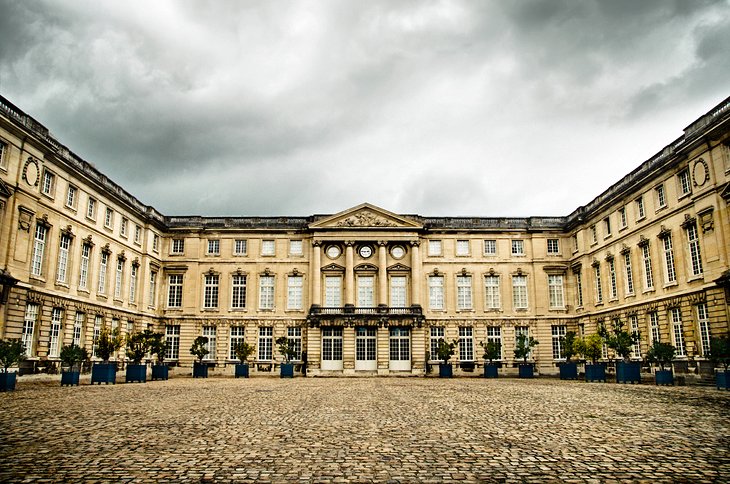
Surrounded by majestic forests, Compiègne defines itself as a "royal village" considering of its majestic past. Here, French Kings and the Emperor Napoleon I take left their mark.
Evidence of the town'south rich heritage are several prestigious monuments, such equally the Hôtel de Ville (Town Hall), a unique example of secular Gothic architecture, and the Château de Compiègne, the palace of Louis Xv and Louis XVI, every bit well equally Napoleon I and Napoleon 3.
The Château de Compiègne is open up to the public twelvemonth-round for self-guided or guided tours. Visitors volition exist dazzled by the palace'due south Neoclassical architecture and opulent Imperial apartments of the First (Napoleon I) and 2nd (Napoleon Three) French Empires. The palace as well has three museum collections and a tea salon in the rose garden, the Salon de Thé du Jardin des Roses.
Nigh ten kilometers from Compiègne in a immigration of dumbo woodland, the Mémorial de l'Ceasefire (memorial site and museum) is found in the railway carriage where the Armistice of 1918 was signed. The museum displays stereoscopic (three-dimensional) photographs that bring scenes of World War I to life.
Outside the museum are numerous monuments defended to the fallen soldiers of France. The surrounding area has hiking trails that air current through the tranquil forest.
Noyons
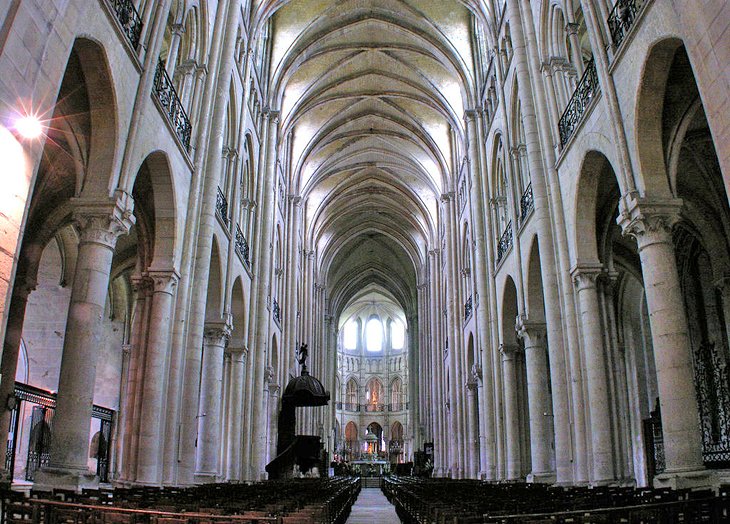
In the center of Picardy, Noyon is an interesting tourist destination with a glorious Romanesque-Gothic cathedral congenital in the twelfth century. With its purity of lines, the Cathédrale Notre-Dame reveals a solemnity and, at the same time, a brightness that inspires spiritual worship. Protestant reformer John Calvin was born in Noyons, and the house of his birthplace is at present the John Calvin Museum, defended to the history of Protestantism.
About 10 kilometers from Noyons, the twelfth-century Abbaye d'Ourscamp was a Cistercian abbey on the medieval pilgrimage route to Santiago de Compostela. Today, the abbey is the property of the Serviteurs de Jésus et de Marie religious customs and is open to the public for visits, equally well equally spiritual retreats.
Somme Battlefields
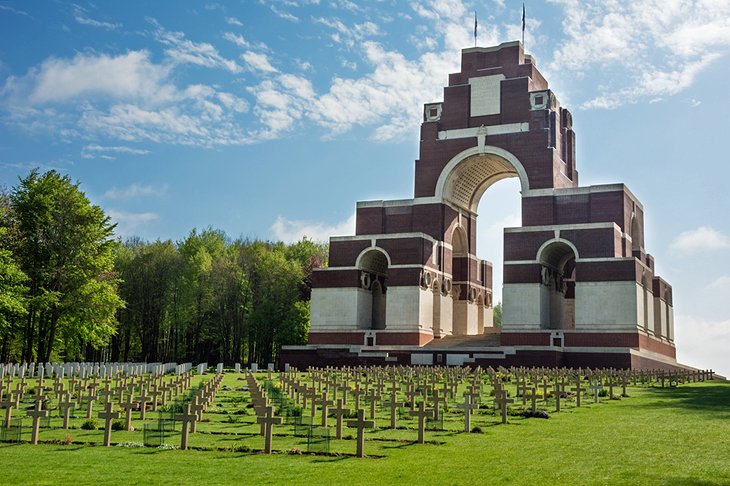
The mural of Somme is the site of a significant WWI battle that took place from July to November in 1916. Visitors tin can acquire about the Boxing of the Somme and discover the history of the war through the Remembrance Circuit, a 92-kilometer-long trail, which includes battleground sites, cemeteries, and memorials.
In the town of Albert at the site of the Battle of the Somme, the Musée Somme 1916 (Somme Trench Museum) documents the history of the First World War and gives visitors a realistic insight of the trench battle experience, with recreations of scenes showing soldiers in the trenches.
Location De Voiture Pas Cher Leclerc,
Source: https://www.planetware.com/tourist-attractions-/nord-pas-de-calais-f-cal-caa.htm
Posted by: clarkemadis1962.blogspot.com


0 Response to "Location De Voiture Pas Cher Leclerc"
Post a Comment